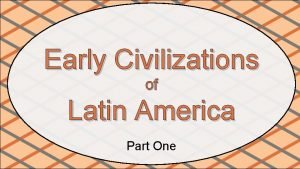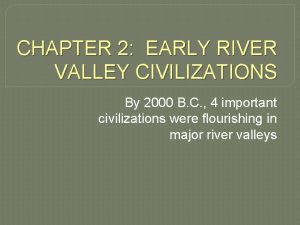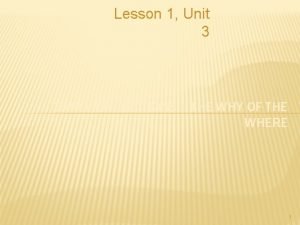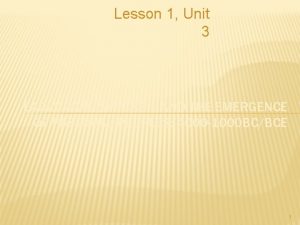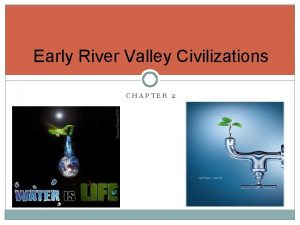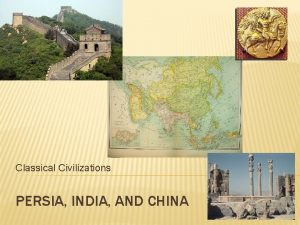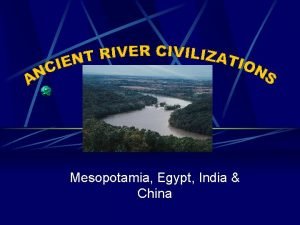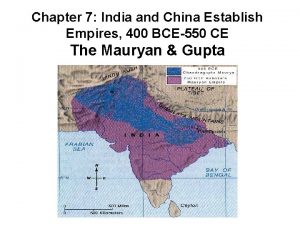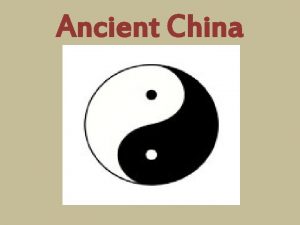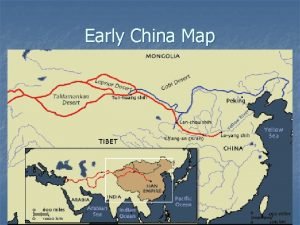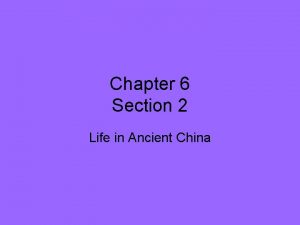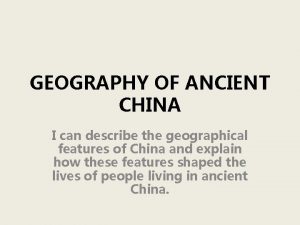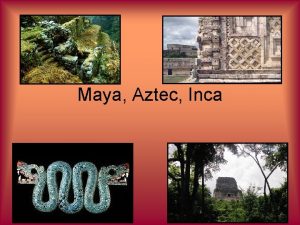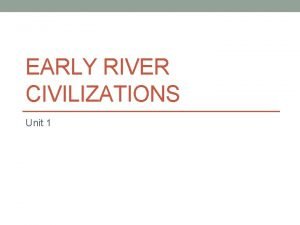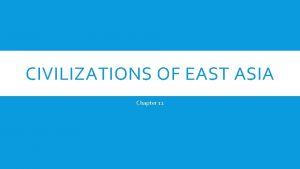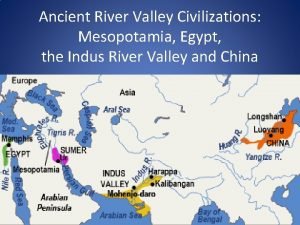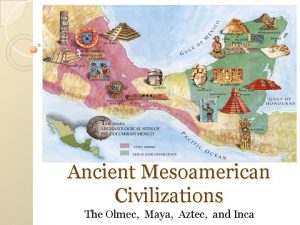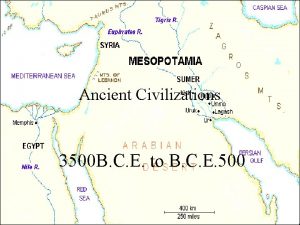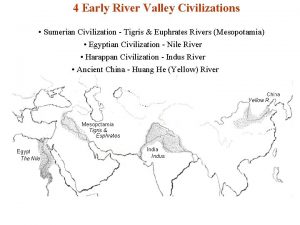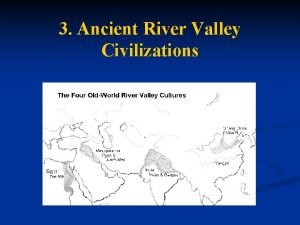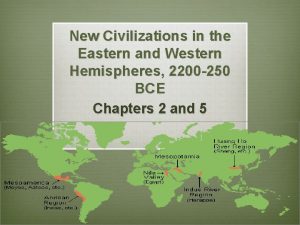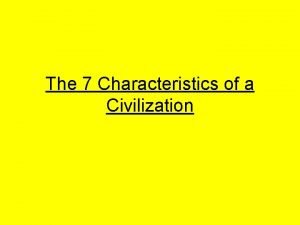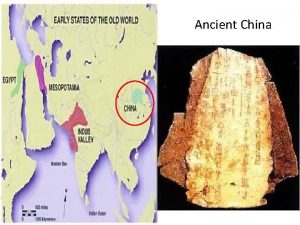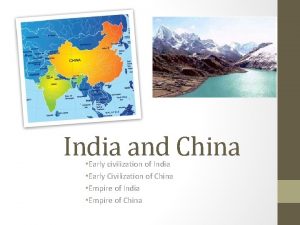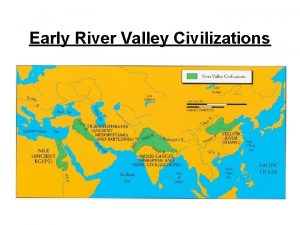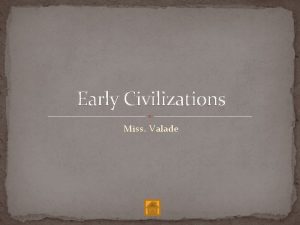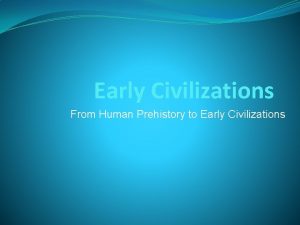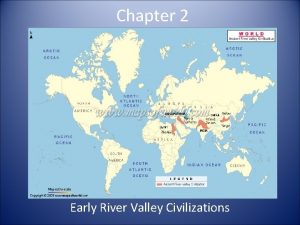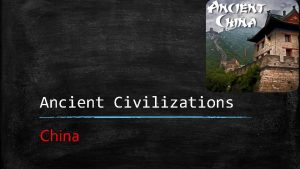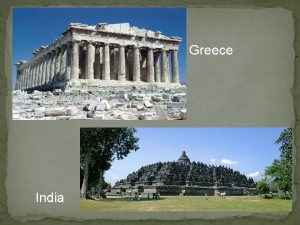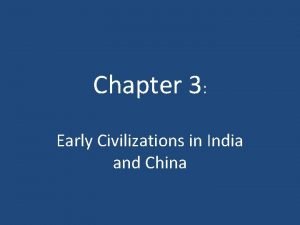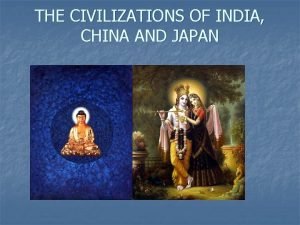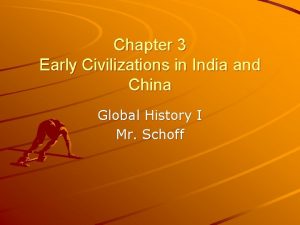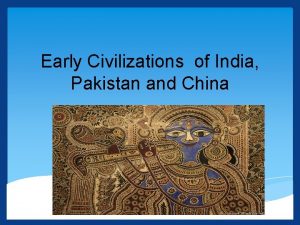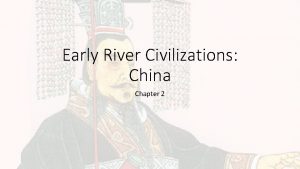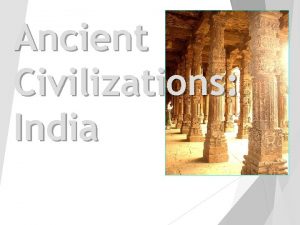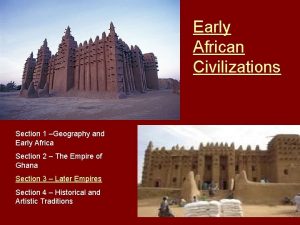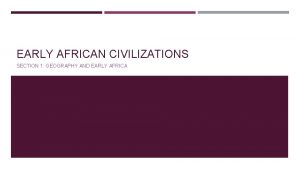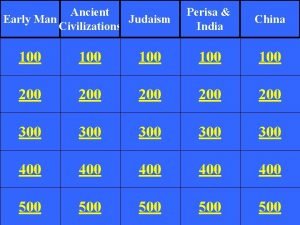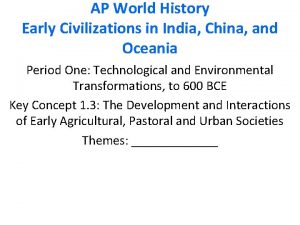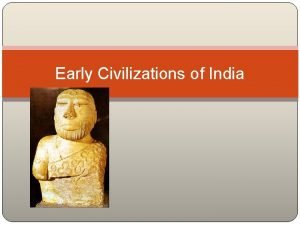Early Civilizations in India and China India Geography













![Varna (Social Hierarchy) Brahmins Kshatriyas Vaishyas Shudras Pariahs [Harijan] Untouchables Varna (Social Hierarchy) Brahmins Kshatriyas Vaishyas Shudras Pariahs [Harijan] Untouchables](https://slidetodoc.com/presentation_image_h/05631a7dc450171514e09ca4e3bfa17a/image-14.jpg)

























- Slides: 39

Early Civilizations in India and China

India • Geography: The Indian Subcontinent – Indus valley is located in the region India – Subcontinent- large landmass that juts out from a continent • India, Pakistan, and Bangladesh – Mountain ranges, Hindu Kush and Himalayas are at the Northern border • Limited contact with India and other lands- Cultural Diversity

Three Regions • Northern Plain – Well watered, just south of the mountains – Many rivers- Indus, Ganges, Brahma putra • Carried melting snow down the mountains • Deccan Plateau – Dry and triangular shaped, juts into ocean • Lacks snow that come from the mountains, land is dry • Coastal Plains – Separated from Deccan by low lying mountain ranges-Eastern and Western Ghats • Rivers and seasonal rains provide water


• Monsoons- Seasonal winds and rain – In Oct. winds flow hot dry air – In June, moisture flows over and drenches crops • Cultural Diversity – India’s big size & diverse landscapes made it hard to unite

• Indus Valley Civilization – Emerged in what is present day Pakistan (2500 BC) – Flourished for 1000 years – Archeologists discovered the once prosperous cities • Have not uncovered all • Indus Valley covered largest area of any civilization until the rise of the Persian Empire

• Well Planned Cities – Harappa and Mohenjo-Daro, twin capitals • • • Both large, 3 miles in circumference Massive hilltop structure (fortress or temple) Had warehouses to store food surplus All houses built of uniform oven-fried clay bricks Modern plumbing systems, with baths, drains, water chutes that lead to sewer beneath streets

• Farming and Trade – Grew wheat, barley, melons and dates – First people to cultivate cotton and weave fibers into cloth – Merchants and traders • Ships carried cargos of cotton, grain, copper, pearls and ivory • Religion – Finding of many statues shows they were polytheistic – Mother goddess wildly honored – Worshipped sacred animals, (bull), -Indian beliefs

• Decline and Disappearance – 1750 BC, quality of life was declining, order became unstable • Causes- Ecological disasters- Volcanic eruptions, earthquakes, deforestation • Aryans, migrated and overtook land with horse drawn carriages

Kingdom of the Ganges • The Vedic Age – Aryans migrated across Europe and Asia seeking water and pasture for horses and cattle – Early Aryans didn’t build cities – Most of what we know comes from the Vedas. Collection of prayers, hymns, and other religious teachings

• Aryan priests recited and memorized the Vedas 1000 years before they were written down • 1500 BC-500 BC known as Vedic Age

• Aryan Society-Divided people by occupation – Brahmins- Priests, claimed they alone could conduct ceremonies needed to win favor of the gods – Kshatriyas- Warriors, first enjoyed highest prestige, priests eventually gained most respect – Vaisyas- Herders, farmers, artisans and merchants

• Aryans felt superior to the Dravidians, people they conquered – Dravidians descended from original inhabitants of Indus Valley – Non-Aryans, separated into fourth group, the Sudrasfarm workers, servants, laborers • Class divisions came to reflect social and economic roles more than racial differences • Became castes, social groups into which people are born and from which they cannot change
![Varna Social Hierarchy Brahmins Kshatriyas Vaishyas Shudras Pariahs Harijan Untouchables Varna (Social Hierarchy) Brahmins Kshatriyas Vaishyas Shudras Pariahs [Harijan] Untouchables](https://slidetodoc.com/presentation_image_h/05631a7dc450171514e09ca4e3bfa17a/image-14.jpg)
Varna (Social Hierarchy) Brahmins Kshatriyas Vaishyas Shudras Pariahs [Harijan] Untouchables

• Aryan Religious Beliefs – Polytheistic – Worshipped Gods and Goddesses that embodied natural forces – Honored animals – Brahmins offered sacrifices of food and drink – Eventually religious leaders wanted one spiritual power • Brahman-resided in all things • Mystics- People who devote their lives to seeking spiritual wealth • Meditation and Yoga- Mystics looked for direct communication with divine forces

• Expansion and Change – Aryans travelled over mountain passages into Northwest India – Aryan tribes were lead by chiefs called rajahs, most skilled war leader

• Colonization of Ganges – Made tools out of Iron – Made cities in the jungle, rajahs ruled them – Developed written language, Sanskrit • Priests began writing sacred texts

• Heroic Deeds and Morals – Mahabharata – Ramayana

Early Civilization in China • Geography: The Middle Kingdom – Ancient Chinese called their land the Zhongguo, the Middle Kingdom – Very isolated • Long distances and physical barriers kept it from Egypt, the Middle East and India • Isolation contributed to belief that China was the center of the Earth – Sole source of civilization

• Geographic Barriers – To the West and Southwest of China, high mountains, Tien Shan and Himalayas – Southeast, full of thick jungles divided China from Southeast China – North, Gobi Desert – East, Pacific Ocean

• The barriers didn’t stop the Chinese from trading with other people, the Middle East • Nomads and invaders entered China and accepted Chinese superiority

• Main Regions – Chinese heartland lay along the east coast and the valleys of Huang He (Yellow River) and the Yangtze • Fertile farming region supported large populations

• Other Regions: – Xinjiang, Mongolia, Manchuria – China also extended influence on Himalayan region Tibet and Xizang

• River of Sorrows – Huang He got its name from the loess, fine windblown yellow soil – Earned nickname, “River of Sorrows”, as loess settles to the river bottom, it raises water level • Overflowing river killed many

• Shang Dynasty – 1650 BC, people called the Shang gained control of Northern China, near Huang He – Dominated region until 1027 BC, during this time Chinese civilization took shape

– Government • Archaeologists uncovered large palaces and rich tombs of Shang rulers • Noble women had considerable status • King controlled small area, princes and nobles loyal to King governed most of the land • Heads of important clans, groups of families that claimed a common ancestor

– Social Classes • Royal Family • Shang warriors- used leather armor, bronze weapons, and horse drawn chariots • Artists and Merchants- Produced goods for nobles, organized trade • Peasants- Clustered together in farming villages, all families worked in the fields, had to prepare damns for the flooding rivers

• Religious Beliefs – In Shang Dynasty the Chinese developed complex religious beliefs – Prayed to many Gods and nature spirits • Shang Di- Mother Goddess – Veneration of Ancestors • Shang Di would not respond to mere mortals, only to spirits of greatest mortals • Prayed to Ancestors to pray to God

• Yin and Yang – Delicate balance between two forces – Yin- Linked to Earth, darkness and female forces – Yang- Stood for Heaven, light and male forces • Forces were not in opposition, depended on harmony

• System of Writing – Ideographs- Signs that expressed thoughts or ideas – Consulted ancestors with Chinese writing written on oracle bones, used by priests to predict the future

– Written Chinese took shape almost 4, 000 years ago – Over time, evolved to include tens of thousands of characters – Most difficult language to learn – Chinese scholars turn to calligraphy, fine handwriting, into an art form

The Zhou Dynasty • Around 1027 BC, the Zhou people overthrew the Shang dynasty • Zhou dynasty lasted until 256 BC

• Mandate of Heaven – The Zhou justified their takeover of the Shang by declaring they had a divine right to rule – Declared cruelty of last Shang ruler outraged the gods – Gods passed mandate of heaven (Devine right to rule)to the Zhou, who then treated the people well

• Dynastic Cycle – The rise and fall of dynasties – As long as a dynasty provided good government it would enjoy the mandate of heaven – If rulers became corrupt, Chinese believed Heaven would withdraw support

• Feudal State – Rewarded supporters by granting them control over different regions – China became a feudal state – Feudalism- a system of government in which local lords governed their own lands but owed military service and other forms of support to the ruler – Zhou kings ruled China and enjoyed great power and prestige for 250 years – After 771 BC, feudal lords exercised the real power and profited from the lands worked by peasants, within in their domains (rule)


• Economic Growth – China’s economy grew under the Zhou period – Learned ironworking in 500 BC • Iron axes, ox-drawn iron plows, replaces wooden and stone tools – Peasants grew new crops, such as soybeans • Feudal lords organized large-scale irrigation works – Chinese began to use money for the first time • Copper coins had holes in the center to be strung on cords • Merchants benefited from new roads and canals

– Economic expansion lead to an increase in population – People from the Huang He heartland overflowed into central China and began to farm the immense Yangzi basin – Feudal nobles expanded their territories and encouraged peasants to settle there – China increased in size, population and prosperity

• Chinese Achievements – Astronomers studied the movements of planets and recorded eclipses of the sun • Developed an accurate 365 ¼ calendar – Chinese discovered how to make silk around 1000 BC • Became China’s most valuable export, trade route between China and Middle East was the Silk Road – Chinese made the first books • Bound thin strips of wood or bamboo
 Chapter 9 lesson 1 early civilizations
Chapter 9 lesson 1 early civilizations China big idea
China big idea Early south american civilizations
Early south american civilizations Chapter 11 section 1 early civilizations of africa
Chapter 11 section 1 early civilizations of africa Chapter 14 test form a pre columbian america answers
Chapter 14 test form a pre columbian america answers Chapter 2 early river valley civilizations
Chapter 2 early river valley civilizations Geographic luck definition
Geographic luck definition Answer
Answer Chapter 2 early river valley civilizations
Chapter 2 early river valley civilizations The two classical civilizations of ancient india were the
The two classical civilizations of ancient india were the Early cpr and early defibrillation can: *
Early cpr and early defibrillation can: * Comparative development experiences of india and china
Comparative development experiences of india and china Map of mesopotamia egypt india and china
Map of mesopotamia egypt india and china Chapter 7 india and china establish empires
Chapter 7 india and china establish empires Han emperors
Han emperors Early china map
Early china map Why did many aristocrats favor the philosophy of legalism?
Why did many aristocrats favor the philosophy of legalism? Ancient rome outcomes geography and early republic
Ancient rome outcomes geography and early republic China's geography
China's geography Mapping maya inca aztec
Mapping maya inca aztec India china
India china Mesopotamia características políticas
Mesopotamia características políticas Ancient india vs ancient china
Ancient india vs ancient china Frq ap human geography format
Frq ap human geography format 5 themes of geography ap human geography
5 themes of geography ap human geography Proruption ap human geography
Proruption ap human geography Ancient river valley civilizations map
Ancient river valley civilizations map 4 river valley civilizations
4 river valley civilizations Lesson quiz 11-3 civilizations of east asia
Lesson quiz 11-3 civilizations of east asia River valley civilization map
River valley civilization map Inca maya aztec olmec timeline
Inca maya aztec olmec timeline 3,500 bce
3,500 bce River valley civilizations map
River valley civilizations map What is believed to be the 1 stdynasty of ancient china?
What is believed to be the 1 stdynasty of ancient china? Third wave civilizations
Third wave civilizations Mediterranean civilizations location hemisphere
Mediterranean civilizations location hemisphere Which civilizations were the first to record measurements?
Which civilizations were the first to record measurements? World civilizations the global experience ap edition
World civilizations the global experience ap edition World civilizations the global experience 7th edition
World civilizations the global experience 7th edition What are the 7 characteristics of civilizations?
What are the 7 characteristics of civilizations?


